Spatial Heterogeneity of CDOM, Optical Brighteners, and Oils in Mesohaline Tidal Creeks Using Self-Organizing Maps
Abstract
:1. Introduction
2. Materials and Methods
2.1. Site Description
2.2. Materials
2.3. Statistical Analysis and Self-Organizing Maps
3. Results
3.1. Statistical Analysis and GIS Maps
3.2. Self-Organizing Maps
4. Discussion

5. Conclusions
Author Contributions
Funding
Institutional Review Board Statement
Informed Consent Statement
Data Availability Statement
Acknowledgments
Conflicts of Interest
References
- Mustalish, R.A. Optical brighteners: History and technology. Stud. Conserv. 2000, 45, 133–136. [Google Scholar] [CrossRef]
- Agardy, T.; Davis, J.; Sherwood, K. Taking Steps toward Marine and Coastal Management: An Introductory Guide; UNEP: Nairobi, Kenya, 2011; ISBN 9789280731736. [Google Scholar] [CrossRef]
- Archibold, O.W.; Archibold, O.W. Coastal and marine ecosystems. In Ecology of World Vegetation; Springer: Berlin/Hamburg, Germany, 2011. [Google Scholar]
- Aufdenkampe, A.K.; Mayorga, E.; Raymond, P.A.; Melack, J.M.; Doney, S.C.; Alin, S.R.; Aalto, R.E.; Yoo, K. Riverine coupling of biogeochemical cycles between land, oceans, and atmosphere. In Proceedings of the Frontiers in Ecology and the Environment; Wiley: Hoboken, NJ, USA, 2011. [Google Scholar]
- Greene, C.M.; Blackhart, K.; Nohner, J.; Candelmo, A.; Nelson, D.M. A National Assessment of Stressors to Estuarine Fish Habitats in the Contiguous USA. Estuaries Coasts 2015, 38, 782–799. [Google Scholar] [CrossRef]
- Jennerjahn, T.C.; Mitchell, S.B. Pressures, stresses, shocks and trends in estuarine ecosystems-An introduction and synthesis. Estuar. Coast. Shelf Sci. 2013, 130, 1–8. [Google Scholar] [CrossRef]
- Jickells, T. External inputs as a contributor to eutrophication problems. J. Sea Res. 2005, 54, 58–69. [Google Scholar] [CrossRef]
- Larsen, F.W.; Turner, W.R.; Mittermeier, R.A. Will protection of 17% of land by 2020 be enough to safeguard biodiversity and critical ecosystem services? ORYX 2015, 49, 74–79. [Google Scholar] [CrossRef]
- Luisetti, T.; Turner, R.K.; Jickells, T.; Andrews, J.; Elliott, M.; Schaafsma, M.; Beaumont, N.; Malcolm, S.; Burdon, D.; Adams, C.; et al. Coastal zone ecosystem services: From science to values and decision making; a case study. Sci. Total Environ. 2014, 493, 682–693. [Google Scholar] [CrossRef] [PubMed]
- Perillo, G.; Wolanski, E.; Brinson, M.M.; Cahoon, D.R.; Hopkinson, C.S. Coastal wetlands: A Synthesis. In Coastal Wetlands: An Integrated Ecosystem Approach; Elsevier: Amsterdam, The Netherlands, 2019; ISBN 9780080932132. [Google Scholar]
- Carpenter, S.R.; Caraco, N.F.; Correll, D.L.; Howarth, R.W.; Sharpley, A.N.; Smith, V.H. Nonpoint pollution of surface waters with phosphorus and nitrogen. Ecol. Appl. 1998, 8, 559–568. [Google Scholar] [CrossRef]
- Painting, S.J.; Devlin, M.J.; Malcolm, S.J.; Parker, E.R.; Mills, D.K.; Mills, C.; Tett, P.; Wither, A.; Burt, J.; Jones, R.; et al. Assessing the impact of nutrient enrichment in estuaries: Susceptibility to eutrophication. Mar. Pollut. Bull. 2007, 55, 74–90. [Google Scholar] [CrossRef]
- Rabalais, N.N.; Turner, R.E.; Díaz, R.J.; Justić, D. Global change and eutrophication of coastal waters. ICES J. Mar. Sci. 2009, 66, 1528–1537. [Google Scholar] [CrossRef]
- Scavia, D.; Field, J.C.; Boesch, D.F.; Buddemeier, R.W.; Burkett, V.; Cayan, D.R.; Fogarty, M.; Harwell, M.A.; Howarth, R.W.; Mason, C.; et al. Climate change impacts on U.S. coastal and marine ecosystems. Estuaries 2002, 25, 149–164. [Google Scholar] [CrossRef]
- Seitzinger, S.P.; Sanders, R.W. Contribution of Dissolved Organic Nitrogen from Rivers to Estuarine Eutrophication; John Wiley & Sons: Hoboken, NJ, USA, 1997; Volume 159. [Google Scholar]
- Barra Caracciolo, A.; Topp, E.; Grenni, P. Pharmaceuticals in the environment: Biodegradation and effects on natural microbial communities. A review. J. Pharm. Biomed. Anal. 2015, 106, 25–36. [Google Scholar] [CrossRef]
- Lopez De Alda, M.J.; Díaz-Cruz, S.; Petrovic, M.; Barceló, D. Liquid chromatography-(tandem) mass spectrometry of selected emerging pollutants (steroid sex hormones, drugs and alkylphenolic surfactants) in the aquatic environment. J. Chromatogr. A 2003, 1000, 503–526. [Google Scholar] [CrossRef]
- Moreno-González, R.; Rodriguez-Mozaz, S.; Gros, M.; Barceló, D.; León, V.M. Seasonal distribution of pharmaceuticals in marine water and sediment from a Mediterranean coastal lagoon (SE Spain). Environ. Res. 2015, 138, 326–344. [Google Scholar] [CrossRef] [PubMed]
- Pan, B.; Ning, P.; Xing, B. Part V-Sorption of pharmaceuticals and personal care products. Environ. Sci. Pollut. Res. 2009, 16, 106–116. [Google Scholar] [CrossRef] [PubMed]
- Zenker, A.; Cicero, M.R.; Prestinaci, F.; Bottoni, P.; Carere, M. Bioaccumulation and biomagnification potential of pharmaceuticals with a focus to the aquatic environment. J. Environ. Manag. 2014, 133, 378–387. [Google Scholar] [CrossRef] [PubMed]
- Sinkko, H.; Lukkari, K.; Jama, A.S.; Sihvonen, L.M.; Sivonen, K.; Leivuori, M.; Rantanen, M.; Paulin, L.; Lyra, C. Phosphorus Chemistry and Bacterial Community Composition Interact in Brackish Sediments Receiving Agricultural Discharges. PLoS ONE 2011, 6, e21555. [Google Scholar] [CrossRef]
- Levin, L.A.; Ekau, W.; Gooday, A.J.; Jorissen, F.; Middelburg, J.J.; Naqvi, S.W.A.; Neira, C.; Rabalais, N.N.; Zhang, J. Effects of Natural and Human-Induced Hypoxia on Coastal Benthos; EGU: Munich, Germany, 2009; Volume 6, Available online: www.biogeosciences.net/6/2063/2009/ (accessed on 15 June 2020).
- Li, P.; Chen, L.; Zhang, W.; Huang, Q. Spatiotemporal distribution, sources, and photobleaching imprint of dissolved organic matter in the Yangtze Estuary and its adjacent sea using fluorescence and parallel factor analysis. PLoS ONE 2015, 10, e0130852. [Google Scholar] [CrossRef]
- Menon, H.B.; Sangekar, N.P.; Lotliker, A.A.; Vethamony, P. Dynamics of chromophoric dissolved organic matter in Mandovi and Zuari estuaries-A study through in situ and satellite data. ISPRS J. Photogramm. Remote Sens. 2011, 66, 545–552. [Google Scholar] [CrossRef]
- Mostofa, K.M.G.; Liu, C.Q.; Vione, D.; Mottaleb, M.A.; Ogawa, H.; Tareq, S.M.; Yoshioka, T. Colored and chromophoric dissolved organic matter in natural waters. In Photobiogeochemistry of Organic Matter; Springer: Berlin/Hamburg, Germany, 2013; pp. 365–428. [Google Scholar] [CrossRef]
- Yang, L.; Guo, W.; Hong, H.; Wang, G. Non-conservative behaviors of chromophoric dissolved organic matter in a turbid estuary: Roles of multiple biogeochemical processes. Estuar. Coast. Shelf Sci. 2013, 133, 285–292. [Google Scholar] [CrossRef]
- Coble, P.G.; Spencer, R.G.M.; Baker, A.; Reynolds, D.M. Aquatic Organic Matter Fluorescence. In Aquatic Organic Matter Fluorescence; Cambridge University Press: Cambridge, UK, 2014; pp. 75–122. [Google Scholar]
- Dickerson, J.W.; Hagedorn, C.; Hassall, A. Detection and remediation of human-origin pollution at two public beaches in Virginia using multiple source tracking methods. Water Res. 2007, 41, 3758–3770. [Google Scholar] [CrossRef]
- Ferrell, G.M.; Grimes, B.H. Effects of centralized and onsite wastewater treatment on the occurrence of traditional and emerging contaminants in streams. J. Environ. Health 2014, 76, 18–27. [Google Scholar] [PubMed]
- Application Note: Optical Brighteners Fluorescence Methods. Available online: www.turnerdesigns.com (accessed on 18 August 2021).
- Billian, H.; Krometis, L.A.; Thompson, T.; Hagedorn, C. Movement of traditional fecal indicator bacteria and source-tracking targets through septic drainfields. Sci. Total Environ. 2018, 610–611, 1467–1475. [Google Scholar] [CrossRef] [PubMed]
- Cao, Y.; Griffith, J.F.; Weisberg, S.B. Evaluation of optical brightener photodecay characteristics for detection of human fecal contamination. Water Res. 2009, 43, 2273–2279. [Google Scholar] [CrossRef] [PubMed]
- Dubber, D.; Gill, L.W. Suitability of fluorescent whitening compounds (FWCs) as indicators of human faecal contamination from septic tanks in rural catchments. Water Res. 2017, 127, 104–117. [Google Scholar] [CrossRef] [PubMed]
- Hartel, P.G.; Hagedorn, C.; McDonald, J.L.; Fisher, J.A.; Saluta, M.A.; Dickerson, J.W.; Gentit, L.C.; Smith, S.L.; Mantripragada, N.S.; Ritter, K.J.; et al. Exposing water samples to ultraviolet light improves fluorometry for detecting human fecal contamination. Water Res. 2007, 41, 3629–3642. [Google Scholar] [CrossRef]
- Hartel, P.G.; Rodgers, K.; Moody, G.L.; Hemmings, S.N.; Fisher, J.A.; McDonald, J.L. Combining targeted sampling and fluorometry to identify human fecal contamination in a freshwater creek. J. Water Health 2008, 6, 105–116. [Google Scholar] [CrossRef]
- Rane, A.; Joshi, S.J. Biodecolorization and Biodegradation of Dyes: A Review. Open Biotechnol. J. 2021, 15, 97–108. [Google Scholar] [CrossRef]
- Salas, H.; Gutiérrez-Bouzán, C.; López-Grimau, V.; Vilaseca, M. Respirometric Study of Optical Brighteners in Textile Wastewater. Materials 2019, 12, 785. [Google Scholar] [CrossRef]
- Mallin, M.A.; Haltom, M.I.; Song, B.; Tavares, M.E.; Dellies, S.P. Bacterial source tracking guides management of boat head waste in a coastal resort area. J. Environ. Manag. 2010, 91, 2748–2753. [Google Scholar] [CrossRef]
- USEPA. National Management Measures Guidance to Control Nonpoint Source Pollution from Marinas and Recreational Boating National Management Measures to Control Nonpoint Source Pollution from Marinas and Recreational Boating; USEPA: Washington, DC, USA, 2001.
- Graham, W.M.; Condon, R.H.; Carmichael, R.H.; D’ambra, I.; Patterson, H.K.; Linn, L.J.; Hernandez, F.J. Oil carbon entered the coastal planktonic food web during the Deepwater Horizon oil spill. Environ. Res. Lett. 2010, 5, 045301. [Google Scholar] [CrossRef]
- Nayar, S.; Goh, B.P.L.; Chou, L.M. The impact of petroleum hydrocarbons (diesel) on periphyton in an impacted tropical estuary based on in situ microcosms. J. Exp. Mar. Bio. Ecol. 2004, 302, 213–232. [Google Scholar] [CrossRef]
- Green, R.E.; Bower, A.S.; Lugo-Fernández, A. First Autonomous Bio-Optical Profiling Float in the Gulf of Mexico Reveals Dynamic Biogeochemistry in Deep Waters. PLoS ONE 2014, 9, e101658. [Google Scholar] [CrossRef]
- Boomer, K.; Boynton, W.; Muller, A.; Muller, D.; Sellner, K. Revisiting Coastal Land-Water Interactions: The Triblet Connection. Available online: http://www.chesapeake.org/stac (accessed on 18 August 2021).
- Watershed Report for Biological Impairment of the South River in Anne Arundel County, Maryland Biological Stressor Identification Analysis Results and Interpretation FINAL; Maryland Department of Environment: Baltimore, MD, USA, 2014.
- Total Maximum Daily Load of Sediment in the Non-tidal South River Watershed, Anne Arundel County, Maryland; Technical Report; Maryland Department of Environment: Baltimore, MD, USA, 2017.
- Hydrolab DS5X, DS5, and MS5 Water Quality Multiprobes; Hydrolab: Austin, TX, USA, 2006.
- ECO 3-Measurement Sensor (Triplet) User’s Guide ECO-Triplet User’s Guide (Triplet) Revision M 11. 2007. Available online: www.wetlabs.com (accessed on 12 August 2021).
- NEMI Method Summary-160.2. Available online: https://www.nemi.gov/methods/method_summary/5213/ (accessed on 20 January 2022).
- Torrence, C.; Compo, G. A practical Guide to wavelet analysis. Bull. Am. Meteorol. Soc. Progr. Atmos. Ocean. Sci. 1998, 79, 61–78. [Google Scholar] [CrossRef]
- Kohonen, T. The self-organizing map. Neurocomputing 1998, 21, 1–6. [Google Scholar] [CrossRef]
- Kim, D.-K.; Jo, H.; Han, I.; Kwak, I.-S. Explicit Characterization of Spatial Heterogeneity Based on Water Quality, Sediment Contamination, and Ichthyofauna in a Riverine-to-Coastal Zone. Int. J. Environ. Res. Public Health 2019, 16, 409. [Google Scholar] [CrossRef]
- Kim, D.K.; Javed, A.; Yang, C.; Arhonditsis, G.B. Development of a mechanistic eutrophication model for wetland management: Sensitivity analysis of the interplay among phytoplankton, macrophytes, and sediment nutrient release. Ecol. Inform. 2018, 48, 198–214. [Google Scholar] [CrossRef]
- Ejarque-Gonzalez, E.; Butturini, A. Self-Organising Maps and Correlation Analysis as a Tool to Explore Patterns in Excitation-Emission Matrix Data Sets and to Discriminate Dissolved Organic Matter Fluorescence Components. PLoS ONE 2014, 9, e99618. [Google Scholar] [CrossRef] [PubMed]
- Richardson, A.J.; Risi En, C.; Shillington, F.A. Using self-organizing maps to identify patterns in satellite imagery. Prog. Oceanogr. 2003, 59, 223–239. [Google Scholar] [CrossRef]
- Chon, T.-S.; Kwak, I.-S.; Park, Y.-S.; Kim, T.-H.; Kim, Y. Patterning and short-term predictions of benthic macroinvertebrate community dynamics by using a recurrent artificial neural network. Ecol. Modell. 2001, 146, 181–193. Available online: www.elsevier.com/locate/ecolmodel (accessed on 13 August 2021). [CrossRef]
- Giraudel, J.L.; Lek, S. A comparison of self-organizing map algorithm and some conventional statistical methods for ecological community ordination. Ecol. Modell. 2001, 146, 329–339. [Google Scholar] [CrossRef]
- Pal, N.R.; Pal1, S. Editorial computational intelligence for pattern recognition. Int. J. Pattern Recognit. Artif. Intell. 2002, 16, 773–779. [Google Scholar] [CrossRef]
- Kohonen and CPANN Toolbox for Matlab-File Exchange-MATLAB Central. Available online: https://www.mathworks.com/matlabcentral/fileexchange/100696-kohonen-and-cpann-toolbox-for-matlab?s_tid=prof_contriblnk (accessed on 12 June 2022).
- Vesanto, J.; Himberg, J.; Alhoniemi, E.; Parhankangas, J. SOM Toolbox for Matlab 5 Libella Oy Espoo 2000 SOM Toolbox for Matlab 5. 2000. Available online: http://www.cis.hut.fi/projects/somtoolbox/ (accessed on 13 August 2021).
- Kohonen, T. Self-Organizing Maps; Springer Series in Information Sciences; Springer: Berlin/Heidelberg, Germany, 2001; Volume 30, ISBN 978-3-540-67921-9. [Google Scholar]
- Wandeto, J.M.; Dresp-Langley, B. The quantization error in a Self-Organizing Map as a contrast and colour specific indicator of single-pixel change in large random patterns. Neural Netw. 2019, 119, 273–285. [Google Scholar] [CrossRef]
- Anne Arundel County South River Watershed Summary Report; Technical Report; CH2MHill, KCI Technology: Englewood, CO, USA, 2008.
- Digitalcommons@uri, D.; Breard, G.T. Evaluating Self-Organizing Map Quality Measures as Convergence Criteria. Master’s Thesis, University of Rhode Island, South Kingstown, RI, USA, 2017. [Google Scholar] [CrossRef]
- Muller, A.; Muller, D. Analysis of nodal point pollution, variability, and sustainability in mesohaline tidal creeks. Mar. Pollut. Bull. 2014, 85, 204–213. [Google Scholar] [CrossRef] [PubMed]
- Moore, C.; Guignet, D.; Maguire, K.B.; Dockins, C.; Simon, N.B. Valuing Ecological Improvements in the Chesapeake Bay and the Importance of Ancillary Benefits. J. Benefit Cost Anal. 2018, 9, 27–66. [Google Scholar] [CrossRef] [PubMed]
- Vallero, D.A. Chapter 3, Environmental Biochemodynamic Processes. In Environmental Biotechnology: A Biosystems Approach; Academic Press: Amsterdam, The Netherlands, 2010. [Google Scholar]
- Zhang, Q.; Murphy, R.R.; Tian, R.; Forsyth, M.K.; Trentacoste, E.M.; Keisman, J.; Tango, P.J. Chesapeake Bay’s water quality condition has been recovering: Insights from a multimetric indicator assessment of thirty years of tidal monitoring data EPA Public Access. Sci. Total Environ. 2018, 637–638, 1617–1625. [Google Scholar] [CrossRef]
- Murphy, R.R.; Kemp, W.M.; Ball, W.P. Long-Term Trends in Chesapeake Bay Seasonal Hypoxia, Stratification, and Nutrient Loading. Estuaries Coasts 2011, 34, 1293–1309. [Google Scholar] [CrossRef]
- Lefcheck, J.S.; Orth, R.J.; Dennison, W.C.; Wilcox, D.J.; Murphy, R.R.; Keisman, J.; Gurbisz, C.; Hannam, M.; Brooke Landry, J.; Moore, K.A.; et al. Long-term nutrient reductions lead to the unprecedented recovery of a temperate coastal region. Proc. Natl. Acad. Sci. USA 2018, 115, 3658–3662. [Google Scholar] [CrossRef]
- Scully, M.E. The Importance of Climate Variability to Wind-Driven Modulation of Hypoxia in Chesapeake Bay. J. Phys. Oceanogr. 2010, 40, 1435–1440. [Google Scholar] [CrossRef]
- Muller, A.C.; Muller, D.L. Forecasting future estuarine hypoxia using a wavelet based neural network model. Ocean Model. 2015, 96, 314–323. [Google Scholar] [CrossRef]
- Williams, M.R.; Wessel, B.M.; Filoso, S. Sources of iron (Fe) and factors regulating the development of flocculate from Fe-oxidizing bacteria in regenerative streamwater conveyance structures. Ecol. Eng. 2016, 95, 723–737. [Google Scholar] [CrossRef]
- Anne Arundel County, MD Septic Systems|GIS Map Data|Anne Arundel County, Maryland|Koordinates. Available online: https://koordinates.com/layer/98935-anne-arundel-county-md-septic-systems/ (accessed on 20 January 2022).
- Newcomer Johnson, T.A.; Kaushal, S.S.; Mayer, P.M.; Smith, R.M.; Sivirichi, G.M. Nutrient Retention in Restored Streams and Rivers: A Global Review and Synthesis. Water 2016, 8, 116. [Google Scholar] [CrossRef]
- Filoso, S.; Smith, S.M.C.; Williams, M.R.; Palmer, M.A. The Efficacy of Constructed Stream-Wetland Complexes at Reducing the Flux of Suspended Solids to Chesapeake Bay. Environ. Sci. Technol. 2015, 49, 8986–8994. [Google Scholar] [CrossRef] [PubMed]
- Goldman, M.A.; Needelman, B.A. Wetland Restoration and Creation for Nitrogen Removal: Challenges to Developing a Watershed-Scale Approach in the Chesapeake Bay Coastal Plain. Adv. Agron. 2015, 132, 1–38. [Google Scholar] [CrossRef]
- Liang, D.; Harris, L.A.; Testa, J.M.; Lyubchich, V.; Filoso, S. Detection of the effects of stormwater control measure in streams using a Bayesian BACI power analysis. Sci. Total Environ. 2019, 661, 386–392. [Google Scholar] [CrossRef]
- Chen, Z.; Doering, P.H.; Ashton, M.; Orlando, B.A. Mixing Behavior of Colored Dissolved Organic Matter and Its Potential Ecological Implication in the Caloosahatchee River Estuary, Florida. Estuaries Coasts 2015, 38, 1706–1718. [Google Scholar] [CrossRef]

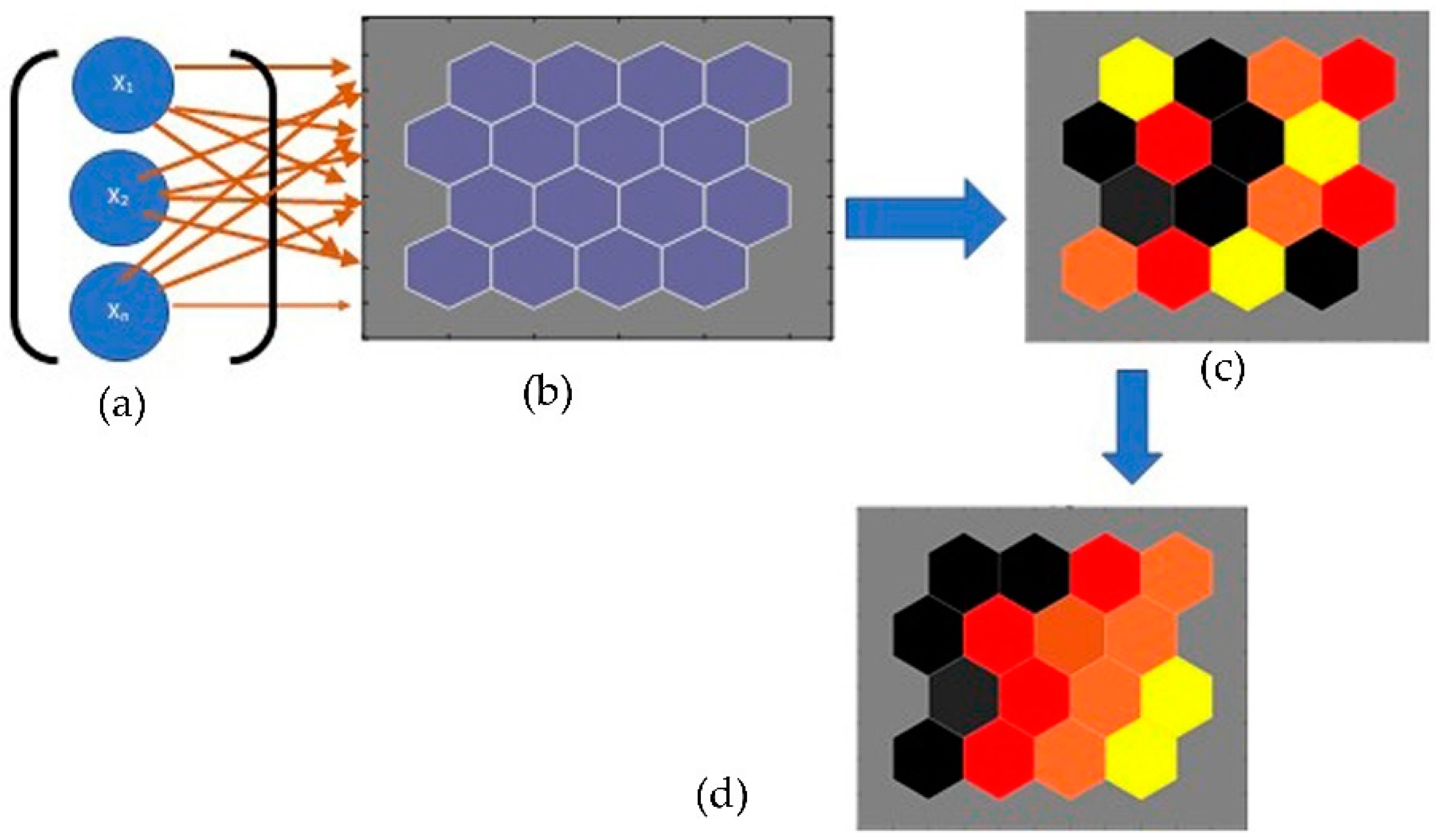
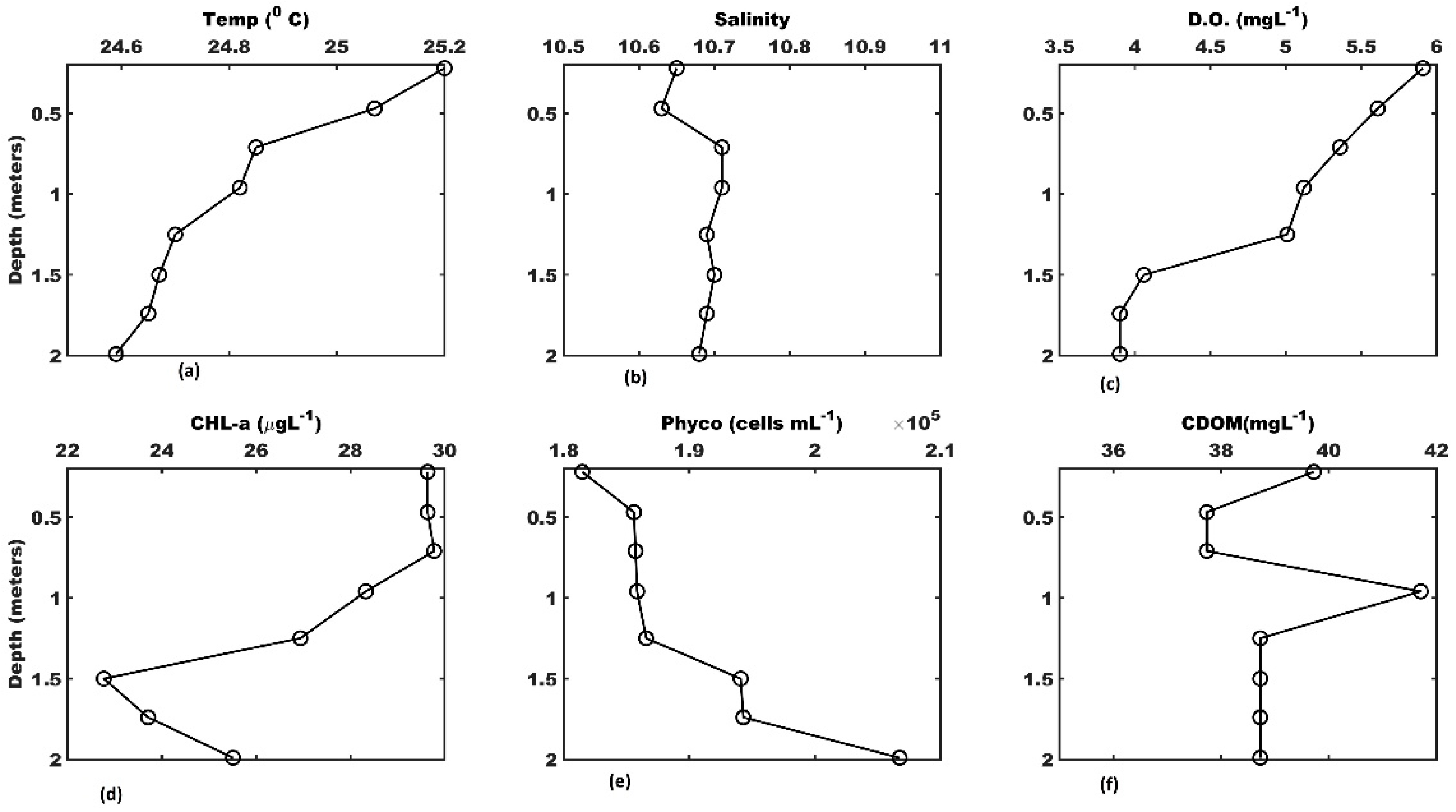
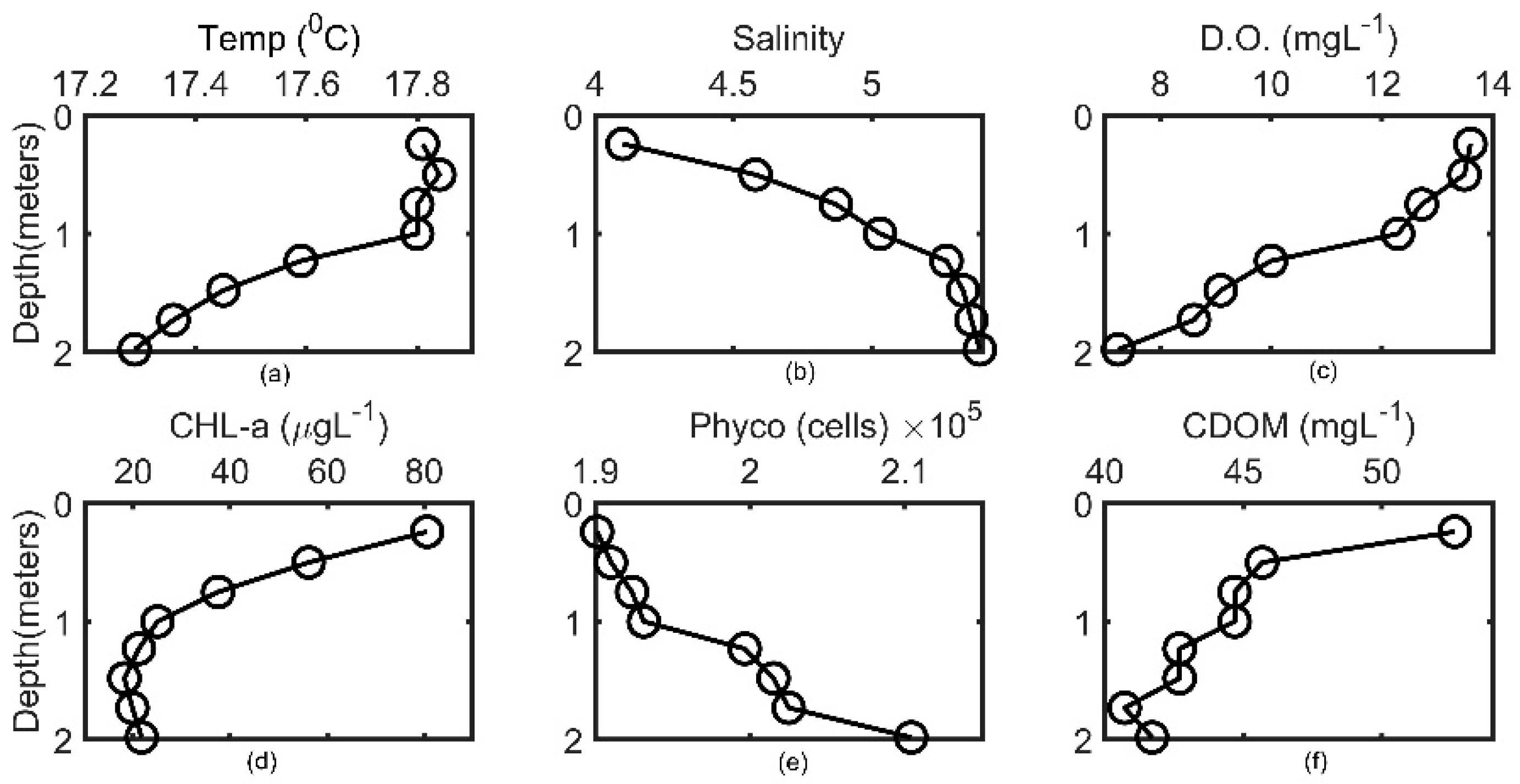

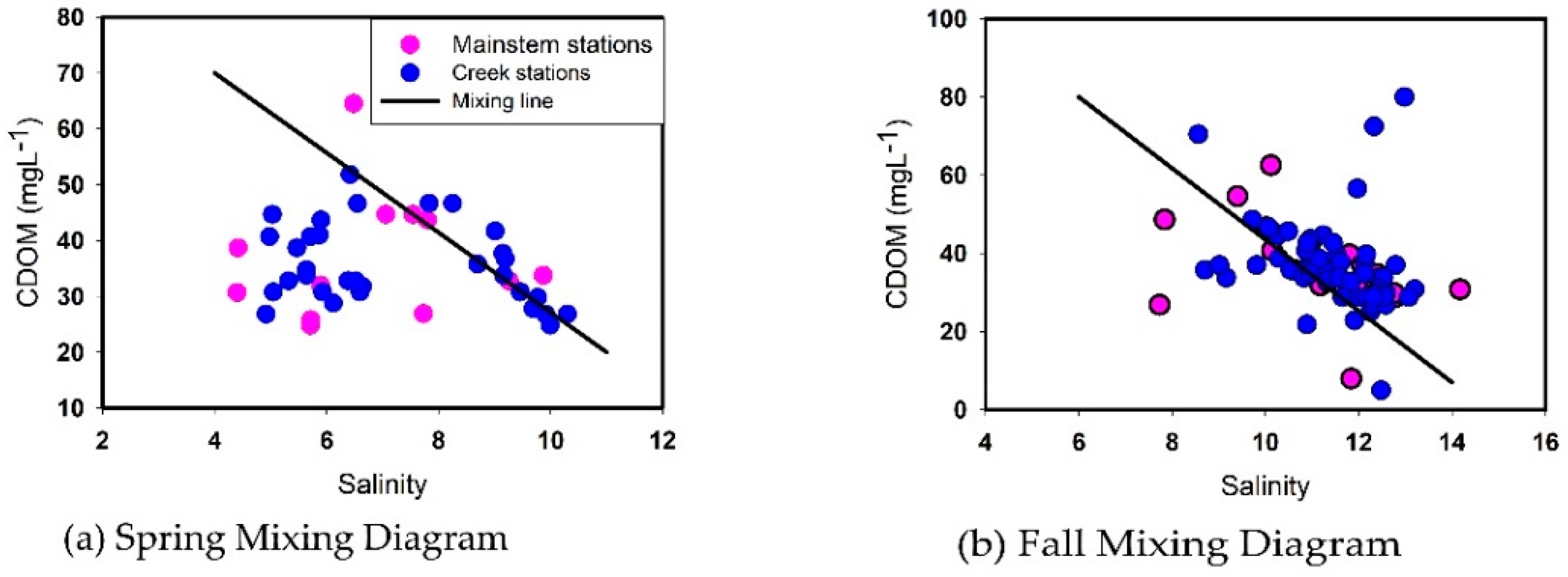

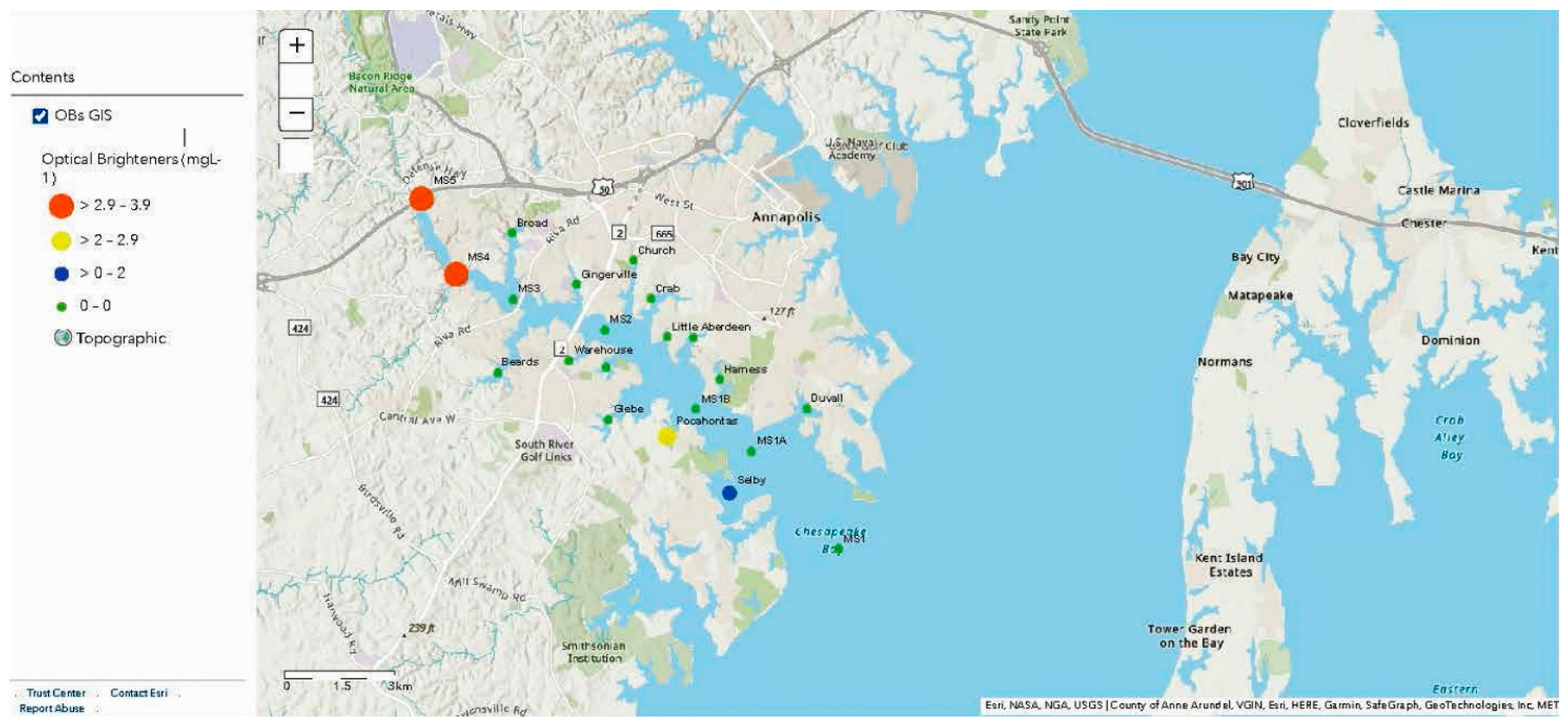

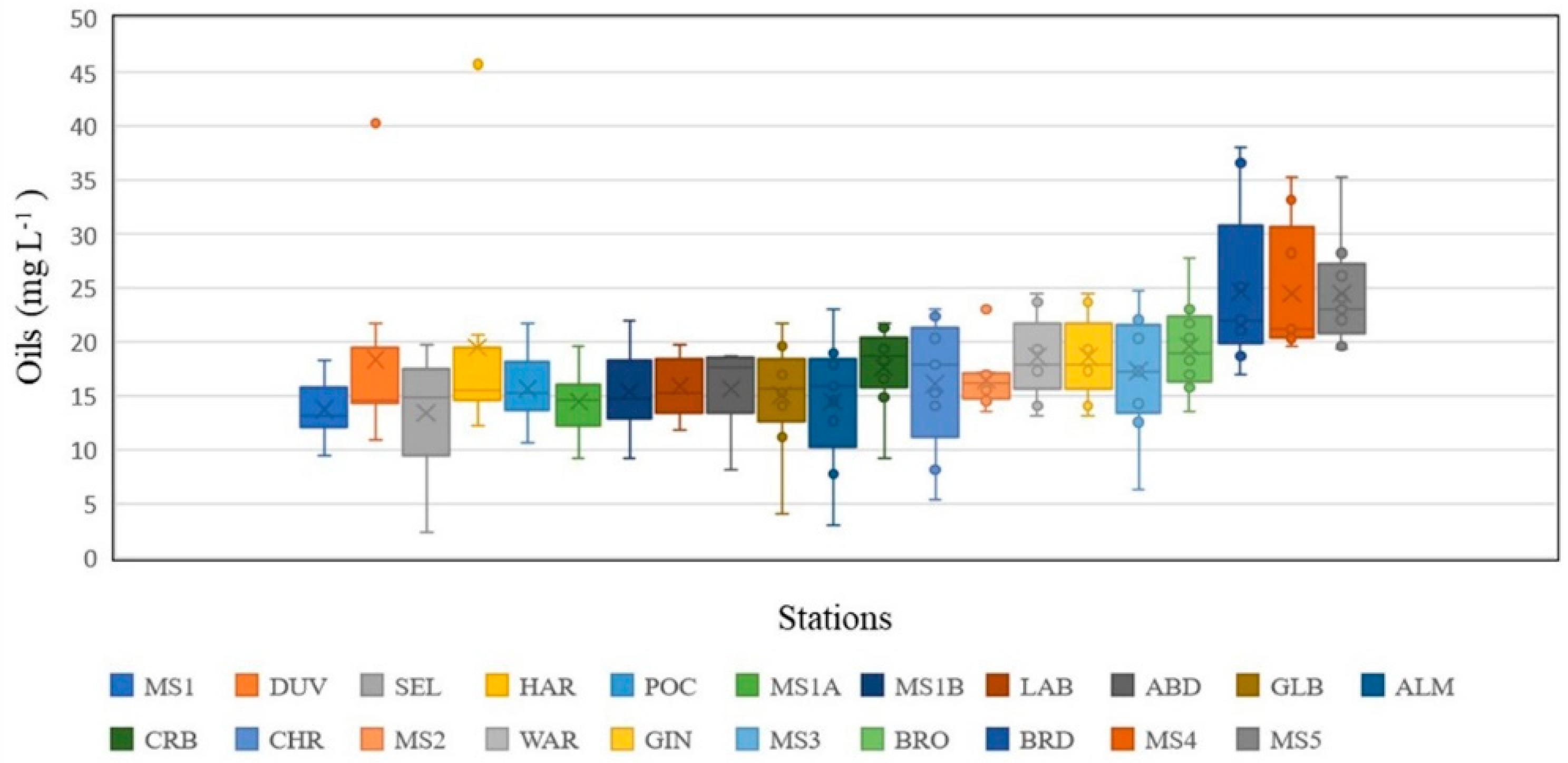

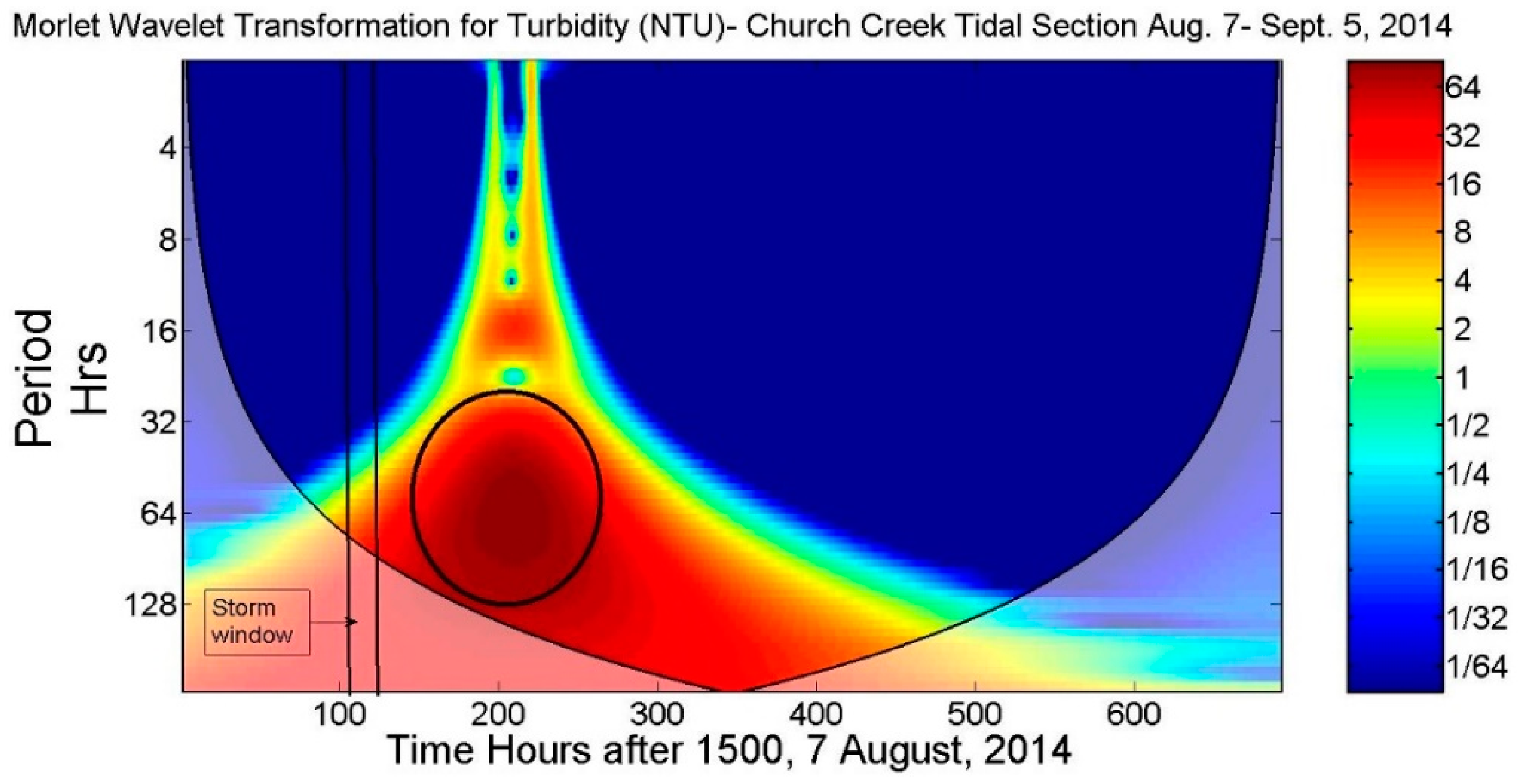
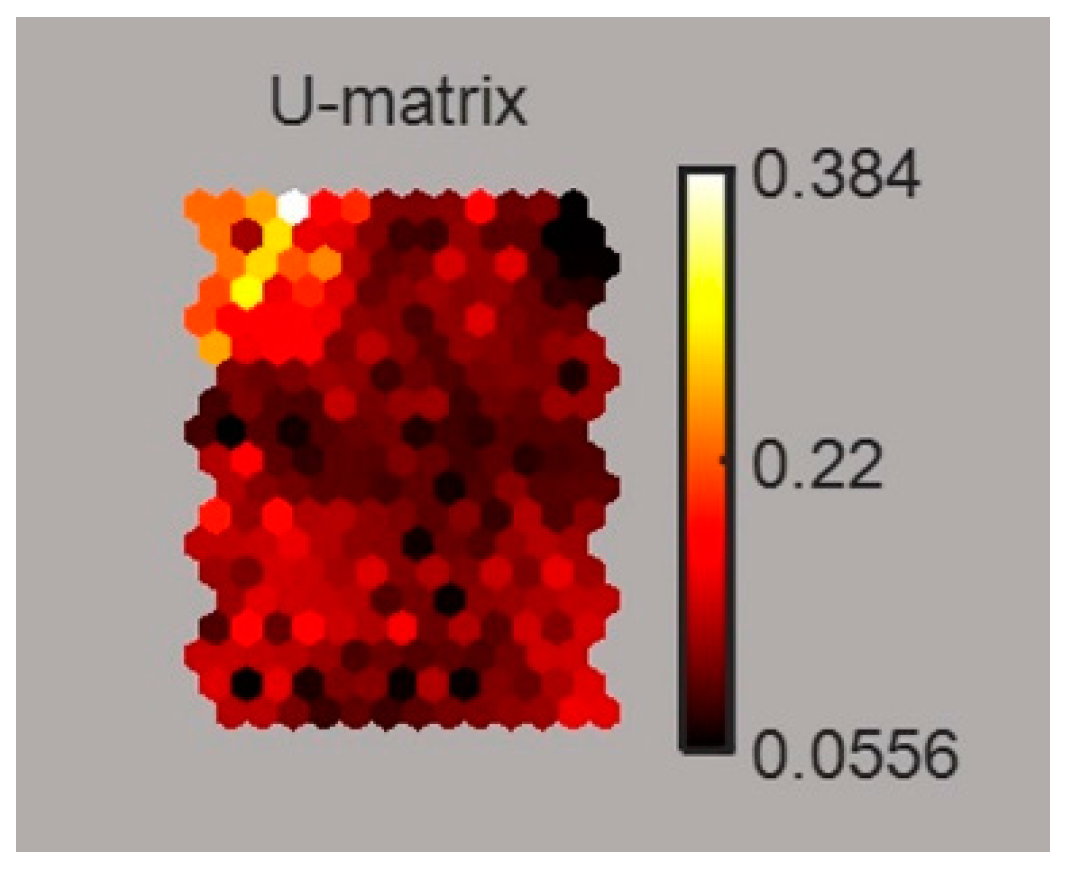
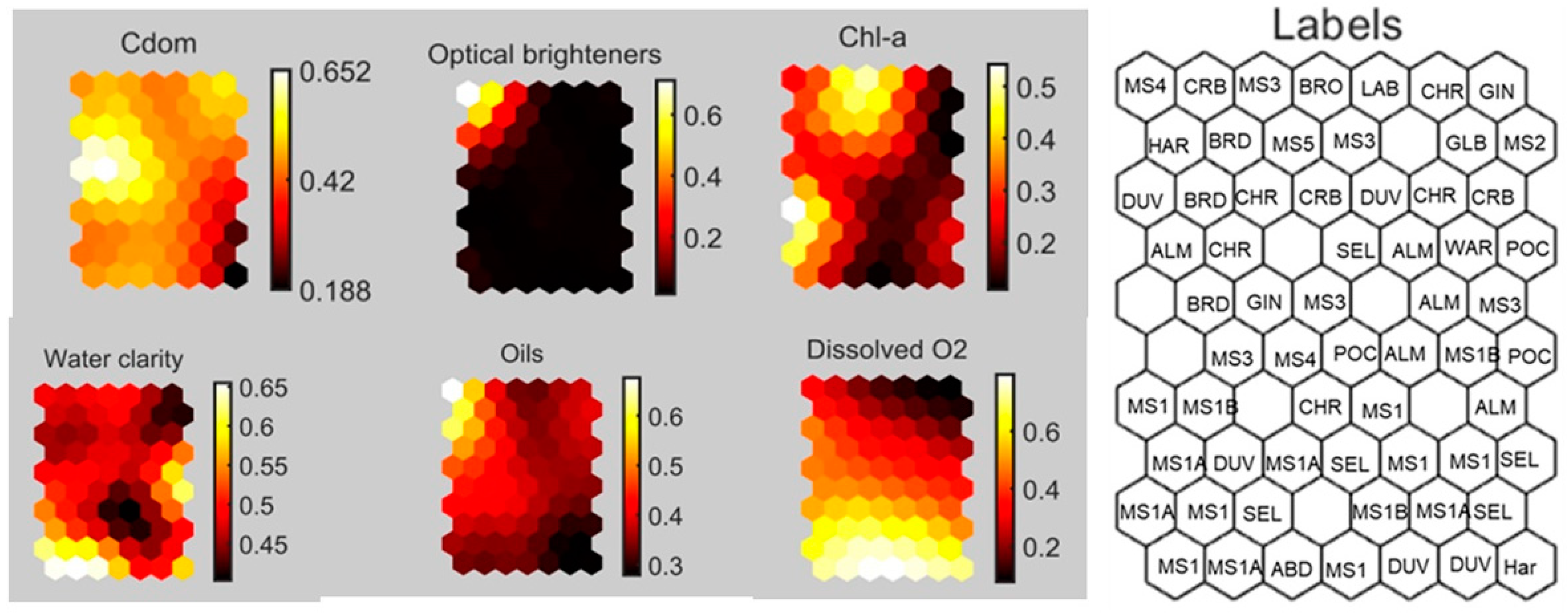
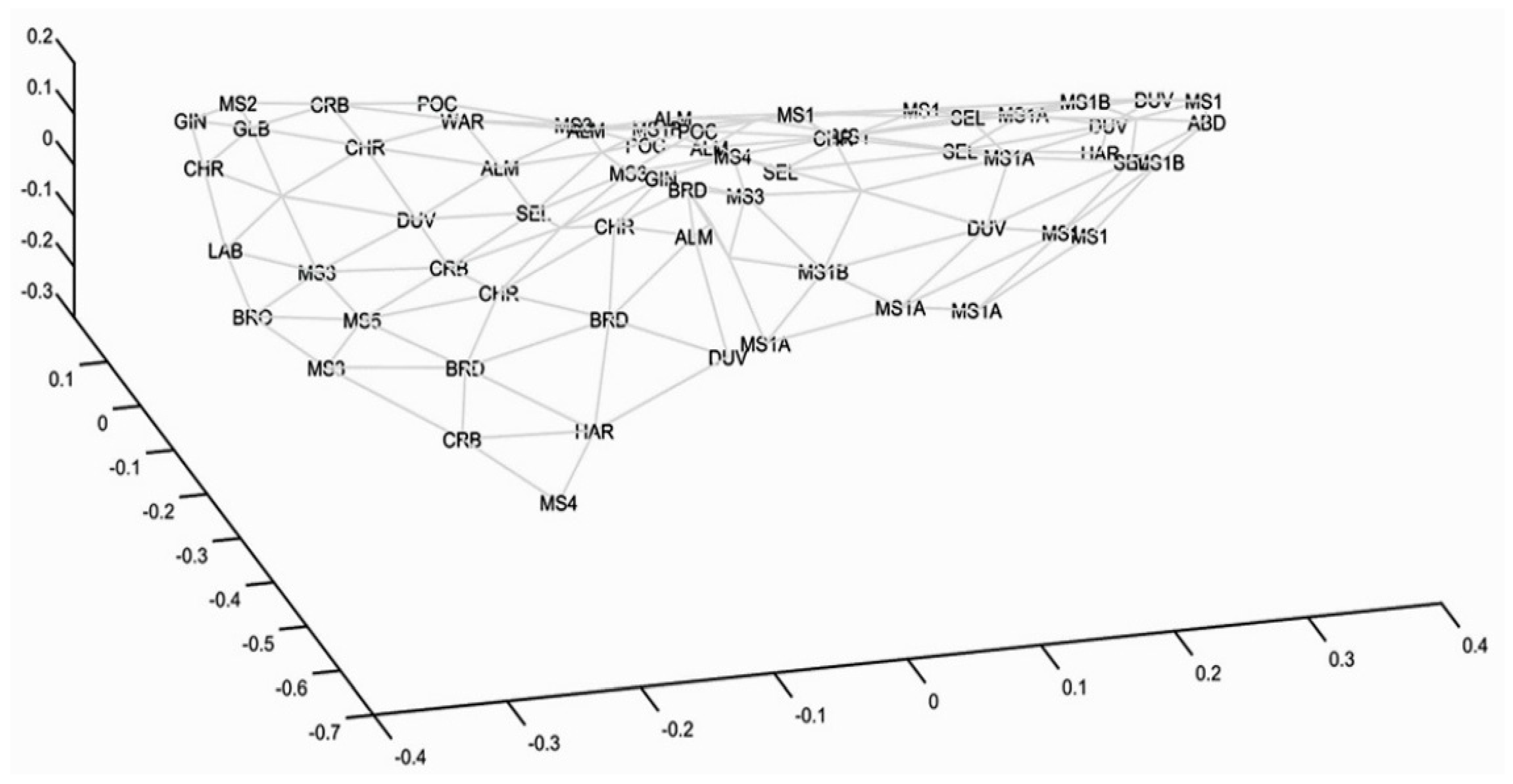
| Designation | Square Kilometers |
|---|---|
| Water | 1.2 |
| Pasture | 2.1 |
| Crop | 6.7 |
| Urban/Suburban | 54.0 |
| Forest | 83.7 |
| Station | Station Type | Average Depth (m) | Distance from Mouth (km) | Characteristics |
|---|---|---|---|---|
| MS1 | Main channel—mouth | 4.5 | 0.0 | Mouth of South River Estuary |
| Duval (DUV) | Tidal embayment | 2.0 | 3.5 | 210 ha |
| Selby (SEL) | Tidal embayment | 3.0 | 3.0 | 158 ha |
| Harness (HAR) | Triblet | 3.0 | 5.4 | 223 ha, 103 septic systems |
| Pocahontas (POC) | Triblet | 2.0 | 164 ha, 2 septic system | |
| MS1A | Main channel | 6.0 | 3.7 | |
| MS1B | Main channel | 6.0 | 5.4 | |
| Little Aberdeen (LAB) | Triblet | 3.0 | 57 ha, 77 septic systems | |
| Aberdeen (ABD) | Triblet | 4.0 | 222 ha; 69 septic systems | |
| Glebe (GLB) | Triblet | 4.0 | 952 ha, 117 septic systems | |
| Almshouse (ALM) | Triblet | 3.5 | 97 ha, 5 septic systems | |
| Crab (CRB) | Triblet | 3.0 | 308 ha, 103 septic systems | |
| Church (CHR) | Triblet | 2.5 | 526 ha, 315 septic systems | |
| MS2 | Main channel | 8.0 | 8.7 | |
| Warehouse (WAR) | Triblet | 2.0 | 142 ha, 52 septic systems | |
| Gingerville (GIN) | Triblet | 2.5 | 250 ha, 166 septic systems | |
| MS3 | Main channel | 4.0 | 11.3 | |
| Beards (BRD) | Triblet | 2.0 | 1845 ha | |
| MS4 | Main channel—mouth of Flat creek, turbidity maximum | 2.0 | 12 | |
| Broad (BRO) | Triblet | 3.0 | 1700 ha, 718 septic systems | |
| MS5 | Main channel—headwaters | 1.6 | 15.0 |
| Tidal Station IDs | 22 Apr 2014 | 8 May 2014 | 13 May 2014 | ||
|---|---|---|---|---|---|
| MS1 | 9.4 | ||||
| MS1A | 10.7 | 11.8 | |||
| MS1B | 10.4 | 7.4 | |||
| MS2 | 10.3 | 9.7 | 5.9 | ||
| MS3 | 11.2 | 10.5 | 7.0 | ||
| MS4 | 12.6 | 11.0 | 9.5 | ||
| MS5 | 18.2 | 14.5 | 12.4 | ||
| Selby | 7.7 | 11.7 | 8.7 | ||
| Pocahontas | 9.7 | 7.8 | 6.9 | ||
| Glebe | 8.6 | 9.7 | 7.7 | ||
| Almshouse | 9.4 | 6.1 | 9.4 | ||
| Warehouse | 11.3 | 11.1 | 11.1 | ||
| Beards | 6.3 | 13.0 | 19.3 | ||
| Duvall | 8.8 | 15.6 | 11.9 | ||
| Harness | 6.2 | 8.2 | 10.7 | ||
| Aberdeen | 7.1 | 10.3 | 9.4 | ||
| Little Aberdeen | 7.5 | 9.8 | 9.6 | ||
| Crab | 7.0 | 9.8 | 3.4 | ||
| Church | 7.2 | 8.1 | 12.9 | ||
| Gingerville | 7.5 | 8.6 | 9.7 | ||
| Broad | 11.2 | 10.8 | 12.4 | ||
| Field Blank | 0.0 | 0.0 | 0.0 | ||
| Lab Blank | 0.0 | 0.0 | 0.0 | ||
| Non-Tidal Creeks | |||||
| Station ID | 15 Apr 2014 | 21 Apr 2014 | 30 Apr 2014 | 15 May 2014 | 28 May 2014 |
| BCS3 | 20.5 | 12.2 | 128.1 | 27.6 | 6.4 |
| BDASH | 13.5 | 9.8 | 110.0 | ||
| BDS3 | 27.2 | 24.4 | 90.0 | 65.6 | |
| BRB2 | 7.0 | 9.0 | 89.0 | 2.2 | |
| CCH1 | 15.5 | 6.1 | 45.0 | 3.8 | |
| CCH2 | 9.6 | 2.3 | 44.0 | 0.7 | |
| CCHRest | 10.0 | 21.0 | 211.6 | 8.0 | |
| CRB1 | 1.1 | 5.9 | 262.9 | 7.1 | 15.4 |
| CRB3 | 10.4 | 128.7 | 43.0 | 43.2 | 85.5 |
| FLT1 | 8.0 | 7.6 | 35.0 | 2.2 | 3.4 |
| GLD1 | 11.0 | 9.1 | 48.0 | 16.0 | 25.3 |
| NTH1 | 5.5 | 3.7 | 4.0 | 2.6 | 0.3 |
| WIL | 4.6 | 4.8 | 5.0 | 4.1 | |
| Field Blank | 0.0 | 0.0 | 0.0 | 0.0 | 0.0 |
| Lab Blank | 0.0 | 0.0 | 0.0 | 0.0 | 0.0 |
Publisher’s Note: MDPI stays neutral with regard to jurisdictional claims in published maps and institutional affiliations. |
© 2022 by the authors. Licensee MDPI, Basel, Switzerland. This article is an open access article distributed under the terms and conditions of the Creative Commons Attribution (CC BY) license (https://creativecommons.org/licenses/by/4.0/).
Share and Cite
Muller, A.C.; Muller, D.L. Spatial Heterogeneity of CDOM, Optical Brighteners, and Oils in Mesohaline Tidal Creeks Using Self-Organizing Maps. Water 2022, 14, 2533. https://doi.org/10.3390/w14162533
Muller AC, Muller DL. Spatial Heterogeneity of CDOM, Optical Brighteners, and Oils in Mesohaline Tidal Creeks Using Self-Organizing Maps. Water. 2022; 14(16):2533. https://doi.org/10.3390/w14162533
Chicago/Turabian StyleMuller, Andrew C., and Diana Lynn Muller. 2022. "Spatial Heterogeneity of CDOM, Optical Brighteners, and Oils in Mesohaline Tidal Creeks Using Self-Organizing Maps" Water 14, no. 16: 2533. https://doi.org/10.3390/w14162533
APA StyleMuller, A. C., & Muller, D. L. (2022). Spatial Heterogeneity of CDOM, Optical Brighteners, and Oils in Mesohaline Tidal Creeks Using Self-Organizing Maps. Water, 14(16), 2533. https://doi.org/10.3390/w14162533






